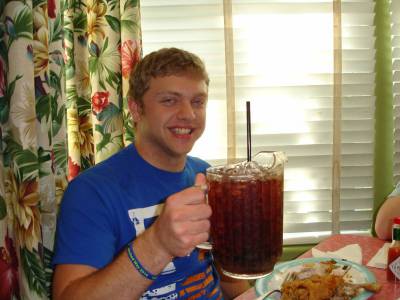Fireworks Photo Ops!
Tips for Taking Great Fireworks Pictures
by Bill Myers, PassPorter Message Board Guide (Moderator)Last modified 6/3/2006
You just love those fireworks and night-time photos. Come on ... admit it ... And most of you will be the first to say "But I can't do THAT!"
Guess what? You can, with your very own digital camera. You don’t need a lot of fancy equipment to take good fireworks and night time photos, not only at Disney, but anywhere.
Many newer cameras come with scene modes on them, and “fireworks” is sometimes one of them. But, beware! If you don’t read that manual and play with your camera ahead of time, you will be disappointed. Most digital cameras set the shutter speed very slow in fireworks mode, sometimes as long as 2 seconds. That means the camera is taking the photo for 2 seconds, and any movement is recorded on the photo. That’s why so many fireworks photos come out blurry.
So what can you do? First, read your camera’s manual, especially the part about the scene modes. Learn what they do and how they work. Secondly, practice, practice, practice. Take outdoor photos at night using those scene modes to get used to how they work. Learn to use them to your advantage. And make sure you have enough “film.” The price of memory cards is dropping and it would be sad to not get the shot you wanted because your memory card is full. (Editor’s Note: We go through our photos every night on our trip and delete ones you KNOW you will never print. You know – those ones where your child’s eyes are closed or your finger is over the lens? Delete those to make room for future fantastic shots.)
Now, how do I hold my camera still for 2 seconds? Well, a tripod would help. What? You don’t carry one around with you at all times? Well, neither do I; in fact, I bring a monopod and tripod to Walt Disney World with me every trip and still forget to carry them with me into the parks. Too much baggage, especially since I don’t have a stroller or something like it to carry it in or on.
For long exposures, anything over 1/60 second, find a fixed object to use - a garbage can, seat back, light pole, rock, or tree trunk … whatever is available. Set your camera on or up against that object to assist in providing stability. So what if you have to hold the camera sideways, you want good photos, right? Besides, you can always rotate the photo to what you want on your computer during the editing process. This will get you the steadiness you need for those slow shutter speeds.
Next, how do I focus? Well, this is a problem, especially with many of the “slower” focusing cameras. Look in your owner manual and see if you can manually focus, or better yet, how to lock a focus setting into memory, or force manual focus to set itself to the one automatically set. What you can do here is manually focus on an object far enough away so that your fireworks will be in focus. In the Magic Kingdom I focus on the Castle, at Epcot I focus on a building across the lagoon from me. I then transfer this focus distance to manual. When using my Olympus “prosumer” cameras, all I have to do is press and hold one button for 3 seconds and it locks the focus distance in. Now, I’m focused and ready to shoot!
Learn to use your body as a tripod. Space your feet firmly under you, turn your body partially sideways to where you’re going take the photos and use your side to support your arm (keeping it close to your side). The hand holding the camera should now be “rigid”, and as you slow your breathing down you make a great tripod for slow shutter speed photos.
Worried about the camera shaking when you push the shutter button? If your camera comes with a remote, then use it, especially if your camera is sitting on a solid object. If you don’t have a remote, or don’t feel comfortable using it, then practice releasing the shutter control - gently push on the button until the shutter releases and you take a picture. Remember, if you jerk your hand or finger to “quickly” get a photo, you will blur the shot at slower shutter speeds. If you’re taking photos of still objects such as The Tower of Terror, Spaceship Earth in Epcot, the fountains in front of Journey Into Imagination, etc. then you can use your self timer. Read the manual on how to use it, but they usually give you a predetermined time between when the button is pushed to take a picture and the actual picture being taken. This time usually ranges from 2 to 10 seconds, and some cameras let you program it. I have taken many, many night photos of the parks using this method; it makes things so easy to do.
And lastly, for you digital folks, look at your photos before you walk off. If your camera allows you to view and zoom in, please do so. It gives you an idea of how the photo looks and whether you need to re-shoot it or try a different method or camera placement. Digital film is cheap, and you can never take too many photos if in the end, you get the one you want.
Remember to take the memories home with you… in pictures!
Updated 6/3/2006 - Article #428
by PassPorter Travel Press, an imprint of MediaMarx, Inc.
Want to know more about Walt Disney World?
Sign up to get our free weekly newsletter with the latest news and updates on Walt Disney World and a 20% discount coupon.
You are in good company -- we have more than 50,000 subscribers!












